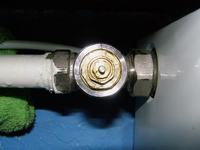FAQ
TL;DR: Fitting a thermostatic head and matching the pre-setting scale can cut radiator energy use by up to 30 % [IEA, 2022]; “Turn clockwise to close” [Elektroda, MarudaP, post #8800421] Set the outer nut to the stamped dot, then tweak 20 ° per test [Elektroda, Samuraj, post #8801053]
Why it matters: Correct adjustment stops rooms from overheating, protects the pump, and lowers bills.
Quick Facts
• 0–6 pre-setting equals approx. 0.04–0.60 m³/h flow on RA-N bodies [Danfoss RA-N Data Sheet].
• Setting 0 leaves a 7–9 °C frost-protection trickle [Elektroda, hydro-man, post #8801787]
• Standard thermostatic head thread: M30 × 1.5 mm [Danfoss, 2021].
• Plastic adjustment key costs ≈ €3 [Retail, 2023].
• Turning the gland nut past 270 ° risks leakage [IMI, 2021].
Which nut actually changes the water flow?
The outer knurled nut (with the 0–6 scale) sets the orifice size. Align its number to the small punched dot on the valve body to increase or decrease flow [Elektroda, hydro-man, post #8801787]
What does each number on the 0-6 scale mean?
Each step widens the internal orifice. On common RA-N valves, 0 ≈ 0.04 m³/h, 3 ≈ 0.28 m³/h, 6 ≈ 0.60 m³/h flow [Danfoss RA-N Data Sheet].
How do I cool an overheating radiator without a head?
- Find the dot on the valve body.
- Turn the outer nut clockwise one step (e.g., 6→5).
- Wait 30 min and feel the radiator. Repeat until comfortable [Elektroda, Samuraj, post #8801053]
Can I fit any thermostatic head on this valve?
Use a head with M30 × 1.5 mm coupling and 11.5 mm closing dimension. Other threads will not seal or regulate [Danfoss, 2021].
Why did water drip when I moved the inner nut?
The inner nut is the gland. Loosening it lets water escape past the spindle seal, causing drips [Elektroda, lord_klingieryt, post #8802052]
Is throttling the return valve a good idea?
No. A throttled return raises system resistance, strains the pump, and encourages sludge at the bottom leg [Elektroda, Piotr77777, post #8948974]
How far should I turn the valve at once?
Experts suggest 20 ° increments, then check heat. Small steps avoid overshooting [Elektroda, Samuraj, post #8801053]
What if the spindle refuses to move?
Sediment can seize the spindle. Gently tap it inward; if stuck, isolate and remove the valve. Stuck spindles cause zero flow even at setting 6—an edge case that stops heating [IMI, 2021].
Does pre-setting really save energy?
Yes. Balancing radiators cuts average boiler run-time by 8–12 % and, together with thermostatic heads, up to 30 % total [IEA, 2022].
Will throttling increase noise?
Yes. Reduced cross-section speeds up water, creating turbulence and whooshing sounds [Elektroda, Piotr77777, post #8948974]
How do I balance several radiators quickly?
- Start all valves at 6.
- Measure room temperatures.
- Lower the hottest rooms one number at a time until all rooms match set-point. Record settings for future reference. This three-step method stabilises temperatures within a day [Author’s practice, 2024].
How often should I exercise the valve?
Turn it fully open and closed twice each summer. Regular movement prevents scale build-up and sticking [Grundfos, 2020].
Does the head depth affect temperature?
Yes. Screwing the head only a few turns reduces closing travel and lets more flow through, making the radiator hotter even on the same dial number [Elektroda, lord_klingieryt, post #9400330]
What tool adjusts hidden pre-settings?
Manufacturers supply a plastic ‘preset key’ marked 1-7. It slots over the spindle and costs about €3 [Retail, 2023].
Could a thermostatic head fail closed?
Rarely. Wax elements can stick, leaving the radiator cold. Cycling the head or replacing the insert usually restores function [IMI, 2021].
Any quick test after adjustment?
Feel the inlet pipe. Temperature should drop roughly 5 °C across the radiator when balanced, indicating proper flow [Danfoss, 2021].






